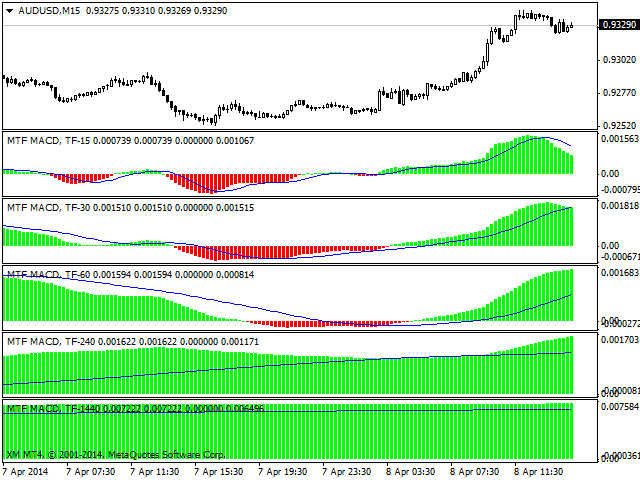- MACD – multiple timeframes
- Indicator name: MACDMTF
- Indicator used: MACD
The main problem with a conventional multi-time frame indicator is the need to REDRAW it if a trader decides to use such an indicator in their trading strategy.
Most likely, you already know how the multi-time frame indicator is redrawn. However, I will still explain with the following example:
Let’s assume that you are using a regular multi-time frame MACD (H4) on the chart (H1). At 15:20, the MACD (H4) fell below 0. What happens on the H1 chart? The MACD on the candlesticks 13: 00, 14: 00 and 15: 00 will fall below zero, so you will miss the intersection of the zero line of the MACD (the main event for Expert Advisors using the MACD).
Our solution is a non-redrawing MTF MACD indicator. We cannot reveal the idea of the indicator, but we guarantee that there will be no redrawing on closed bars.
Supported timeframes: M1,M5, M15, M30, H1, H4, and D1.
- DesiredTF-an empty value is set for the current timeframe.
- DesiredTFHelp – capital letters must be considered. h1 is not suitable for the H1 timeframe. It is also not allowed to use a timeframe less than the current one. For example, you can’t use M5 on the M15 chart.
- FastMAPeriod – fast EMA period (default is 12).
- SlowMAPeriod – the period of the slow EMA (default is 26).
- SignalMAPeriod – the signal EMA period (9 by default).
- TimeFrameChangeAlerts – if true, the indicator activates alerts when the timeframe changes.
- TrendChangeAlerts – if true, the indicator activates alerts when the trend changes on the desired timeframe.
[spoiler title=”Read More…”]
The screenshots show 5 MACD indicators on different timeframes with the default MA settings.
[/spoiler]





